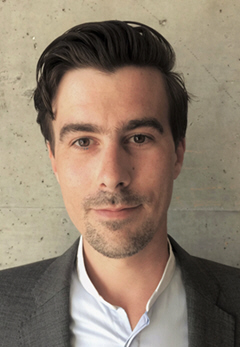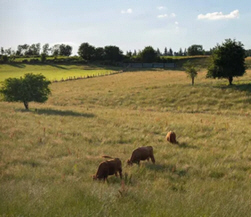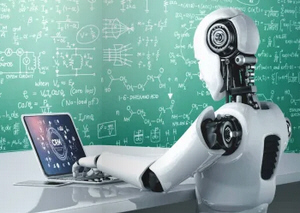Continuing our month-long focus on Data Visualization Sandro Kaulartz, Chief Innovation and Product Development Officer at Ipsos Social Intelligence, talks to MrWeb's Nick Thomas about Topic Modelling, data hybridization and the democratization of data science. Available to read or watch.
Sandro is part of the global leadership team at Ipsos SIA & Synthesio, where he oversees innovation in the domain of Semantic AI and analytic frameworks applied to digital consumer data.
This is an abridged version: for more on tailoring dashboards, user-based innovation and the benefits of humans and machines working together, read or watch the full interview.
NT: Tell us about your parents and their influence on your career and outlook
SK: I grew up in the countryside in West Germany, literally at the border with Belgium, and I was born in a fairly small village that is located in the High Fens Nature Park. So deep forest wildlife, and usually the number of cattle would outnumber humans in the village back then.
My dad grew up on a farm with eight siblings, so social life in my family was always busy and being self- sufficient - very popular theme these days - was pretty much the norm. Growing, cultivating your own food.
 My dad worked for the German railway company. My mum worked in the healthcare industry. But it was really countryside, and to go to work you would usually travel one and a half hours by car.
My dad worked for the German railway company. My mum worked in the healthcare industry. But it was really countryside, and to go to work you would usually travel one and a half hours by car.
My parents are pretty open-minded and they brought us up with a large degree of freedom. Today they regret it because apparently I was trouble as a kid! But I can't remember this part of the story...
It was very clear to me as a countryside boy that life wouldn't hold many free lunches for me, so working hard to really follow your passion and your ideas was very clear to me from the start. And while this country life as a boy was obviously amazing, when you turn into a teenager your ultimate goal is really getting a driver's licence, escaping and exploring big city life.
My Grandpa was someone that I always looked up to: he was a mechanical engineer and in the fifties and sixties he travelled over many continents. I could listen to his stories about foreign cultures and places that I'd never heard of, with great admiration, so I knew that education and ideally getting a university degree is important. He was probably something like a role model, and I went to study macroeconomics and consumer psychology.
Then the classic career path would have been to end up at a management consultancy, but I experienced that as rather dry and dull during an internship. Eventually my diploma professor nudged me towards market research because he spent a short period of his career in research - and I'm very happy that he did.
NT: How has your work developed following Ipsos' acquisition of Synthesio?
SK: Until 2018 our practice was very much report-based, like a classic market research cycle where you get a brief, you process data, you analyse it, you send a report back - but with the acquisition of Synthesio that year we wanted to change our practice and defined a new 'North Star'. Synthesio was and is a very solid platform in terms of data collection and has very good coverage with diverse data sets across the globe, but what we truly wanted to bring to the market was integrating best in breed data science and all the AI models, taxonomies and analytic frameworks we had developed in the past. It was a fundamental change for us also from a business model standpoint - it's an SaaS model but we wanted to introduce services to it - and it's still a journey that we're going through right now, by developing more bitesize use case specific dashboards.
 I think there is quite a significant shift in the market going on. Clients are looking for access to insights, versus data with some analytic tools attached to it, because they very often neither have the time nor the resources to manage that themselves, and scale a platform across the globe. So our vision is to become the leader in AI-enabled consumer intelligence. Last year was really a landmark year for us because we established all the enabling technology that is needed to do that, alongside best in class predictive analytics, so we're getting pretty close to reaching that North Star.
I think there is quite a significant shift in the market going on. Clients are looking for access to insights, versus data with some analytic tools attached to it, because they very often neither have the time nor the resources to manage that themselves, and scale a platform across the globe. So our vision is to become the leader in AI-enabled consumer intelligence. Last year was really a landmark year for us because we established all the enabling technology that is needed to do that, alongside best in class predictive analytics, so we're getting pretty close to reaching that North Star.
Data hybridization is a very important aspect of it. So almost in each and every use case that we work with - trend detection and prediction, brand health, CX, product performance - we actually combine social data with other digital data, and more often than not search data because each data source really brings its individual strengths to the mix. Currently we do a lot of work in predictive modelling for our clients and so diverse data sets are naturally very important to us.
This year, we started to introduce survey data systematically into the platform. Now we are alpha testing with a few selected large clients, the integration of search data in particular for the trend use case. We are constantly expanding the data ecosystem that we are working with.
So we're constantly optimising, but the North Star is to become the leader and set new standards with AI-enabled data science approaches that operate on real-time data, which ultimately aims to cater for insight professionals, and I believe that's what sets us apart. There are many platforms out there, but not everybody's focusing on insight functions which is what we are really trying to do and well. Forrester recently recognised us as one of the few leaders in this new category that they defined, AI-enabled consumer intelligence (AICI).
NT: One of your main new approaches is Topic Modelling...
SK: Last year we introduced topic modelling which is really a milestone for us. Topic Modelling enables you to model, map and size the topic landscape without any human annotation, after you collected a very large data set - lets say thirty million signals around Veganism by means of an example. Now we are able to discover the entire domain, so not just the dominant themes but also really the niche topics, hundreds of really small granular topics from vegan ingredients, recipes, vegan fashion, animal welfare and motivation why consumers turn vegan. It's a really an important change for us and our customers compared to rule-based NLP approaches, where somebody has to write rules based on keywords. It now models and clusters topics autonomously based on context and the meaning dimension.
Let me give you a quick example to make that a little more tangible. If Bill says 'Swiss cheese is very rich and savoury', and Bob says 'I love Gruyere for an umami boost', there's not a single word in common in these two sentences, but the algorithm will be able to identify that on a meaning dimension they are quite similar, semantically speaking, so they would get clustered together.
NT: It's spotting that because it's got libraries which will associate Gruyere with Swiss cheese? Specialist for this piece of research?
SK: Yes. Taxonomies are important, but what this algorithm essentially does, it's a transformer based bidirectional machine learning model, a deep learning technique, and it looks at the entire sentence to try to understand context and how often words that are translated into vectors appear next to each other. Essentially the job is to discover semantic similarities and neighbourhoods in this gigantic vector space and that way it can discover what is the context this person is talking about here.
We now can understand context and meaning from language - and getting that working really for large data streams and real-time data is an engineering challenge as well. You can do that on a data set, but doing that constantly with just a few clicks was really a very important change for us.
When you have a rule based approach, you as a human create rules that says if I'm operating in banking and I want to measure the topic of trust, here are the forty-seven words that I'm looking for, but what really bottom up topic modelling does, is the machine gives you suggestions first, and then you can curate it, you can modify the terms, you can turn them into trackable entities. A very beautiful blend of bottom up / discovery first, a purely data-led approach, but then as an analyst you can turn them into top down topics that you want to continue tracking. You want to modify the suggested topics and turn them, because obviously machines are not always right and then human intelligence is very critical, but it's very powerful. It also adds something new to it, which is the contextual layers that are often hidden to the human eye - so it rules out a lot of subjectivity and it takes a very neutral look at language data, and that's what we are very excited about.
NT: The division's name has 'Social' in it but you're no longer just analysing social media...
SK: We're doing a lot of very interesting work in the trend and early innovation insights discovery domain with large clients. We have a partnership with MIT, with whom we work to bring rigour in terms of innovation science to it because I think the mistake that people make is that just because something is trending, it's also a platform for innovation. Let's take activated charcoal in food. It was a big thing three years ago until the scientists said, 'Hey guys, maybe you stop introducing charcoal into food because at some point it'll cause cancer..'. So the mistake that I see is that corporations get too focused on things that are trending and translated directly into an innovation opportunity, but actually successful innovation that is there to stay needs to solve a valuable consumer problem, and that's what we tried to bring together. This trend domain, as I mentioned earlier, really requires you to work with a diverse set of consumer signals - not just social data, but a lot of search data because they nicely really supplement each other.
In a recent case for a leader in the food category, we looked into the new food ecosystem with a focus on plant-based foods, and discovered all the nano, micro and meta-trends. We predicted what's going to happen in the next twelve months but then the really exciting bit happened when we introduced sales data into the model, to discover what were actually the correlations between social and search signals, and sales data. Then it gets quite impactful because you introduce a powerful mix of highly strategic insights when it comes to where future innovation platforms may live, because we also blend in a perspective on how particular trends address the unmet needs that people have and their pain points; but you also give really tactical insights on KPIs that a company should watch because there is a relationship from an increase in search and an uptake in in sales data six months after.
NT: There may be something that's being heavily talked about and is growing very fast there, but it's not going to impact sales if people aren't happy to pay for it?
SK: Precisely. And it's certainly not an easy task for a data scientist to do that well - that's the key challenge. But I think this will grow and it's an obvious prediction to predict that predictive analytics will continue to grow further! Because we have been talking about it for quite a while, but now it's possible even for very large data sets. Discovering correlations is fine, but the moment you turn that into something very tactical to say, okay, there is a five-week difference between the pickup here and something happening on sales - and we can say that with confidence because we looked at five years of very granular data, so I'm not talking about a survey wave that happens once in a year, but really weekly data signals - so the data science model is quite solid and then things become really interesting.
NT: We've been talking quite a bit about your views of what's happening, what's trending at the moment, but look a bit further ahead for me, what might we be talking about in five years' time?
SK: Five years is a long period, but I think what will happen in the next couple of years in our industry is real depth and efficiency in terms of data science. Clearly video intelligence... I think we made really good headway in analyzing pictures with machine vision techniques, to discover logos, subjects and objects, as well as context from pictures. But now with things like Tik Tok and Reels, which you see across all the platforms, I think moving content will become dominant across platforms. So we need to find good answers for that - technically speaking in terms of machine learning it's not too different from analysing pictures, but obviously processing power is an issue - when you think about how many frames a video has, it's quite a different Pandora's box that we need to open at some point soon.
 NT: Turning computer vision into 'computer viewing' kind of thing... spotting movement in the picture and not just analysing the individual frames?
NT: Turning computer vision into 'computer viewing' kind of thing... spotting movement in the picture and not just analysing the individual frames?
SK: Yeah exactly. And there are good models, like Google does incredible work on that front but for us and our industry overall it's always a challenge. It needs to happen in the live SaaS model, and it's a key challenge but we're doing some tests and you know we believe it's getting somewhere. So at some point video intelligence will become important.
Then, we truly believe in data hybridization: I think it won't be enough to look at social data in a siloed way. I think we need to propose more context and it's different than just hosting and populating different kinds of data. That's really not what we are after. I think there are better tools like Tableau for that. For this use case we want to build meaningful connection points and analytic lenses that combine search and social data - not just doing it for the sake of doing it, and introducing more data into the platform, but really building these strong connection points that lead to value added insights. So that's something that I would foresee.
Next, the entire domain of democratising data science with things like low code or no-code solutions that already exist. Enabling any insight professional to use a machine learning model without having a degree in data science. Mind you, that also means from a human resource standpoint that we need more people that I would call 'data to insight transformers', because you need to understand what an algorithm spits out and turn it into something that can be acted upon and that's maybe a profile that the industry is missing right now, or at least it's not that visible in our day- to day work.
NT: Do you have a Motto, or a phrase that sums up how you work and think?
SK: In general I'm not a big motto person, but a good one in this context is: 'The best way to complain is to create things'. It really brings me back to how I was brought up because I could hear my dad saying something like that. I'm also now the proud Dad of three-year-old twins so there's quite a lot of complaining happening in my private life too, and when I use this quote with them they seem to get the idea! I think it's a very nice one that gets attributed to Seth Godin actually, but originally it came from James Murphy, a great musician and producer. []
[This is an abridged version of the interview: for more on how machines and humans can work together; on tailoring dashboards and interpreting in context; and on Sandro's work studying user-based innovation with associates at MIT, read the full interview in the Data Viz supplement, or watch the video here]
All articles 2006-23 written and edited by Mel Crowther and/or Nick Thomas, 2024- by Nick Thomas, unless otherwise stated.
Register (free) for Daily Research News
REGISTER FOR NEWS EMAILS
To receive (free) news headlines by email, please register online